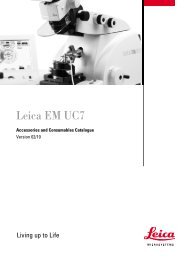Physical Principles of Electron Microscopy: An Introduction to TEM ...
Physical Principles of Electron Microscopy: An Introduction to TEM ...
Physical Principles of Electron Microscopy: An Introduction to TEM ...
Create successful ePaper yourself
Turn your PDF publications into a flip-book with our unique Google optimized e-Paper software.
<strong>Electron</strong> Optics 53<br />
y +V 1<br />
+V 2<br />
-V 2<br />
z<br />
x<br />
-V 1<br />
-V 1<br />
+V 2<br />
+V 1<br />
-V 2<br />
S<br />
N N<br />
z<br />
(a) (b)<br />
Figure 2-16. (a) Electrostatic stigma<strong>to</strong>r, viewed along the optic axis; (b) magnetic quadrupole,<br />
the basis <strong>of</strong> an electromagnetic stigma<strong>to</strong>r.<br />
In practice, we cannot predict which azimuthal direction corresponds <strong>to</strong><br />
the smallest or the largest focusing power <strong>of</strong> an astigmatic lens. Therefore<br />
the direction <strong>of</strong> the stigma<strong>to</strong>r correction must be adjustable, as well as its<br />
strength. One way <strong>of</strong> achieving this is <strong>to</strong> mechanically rotate the quadrupole<br />
around the z-axis. A more convenient arrangement is <strong>to</strong> add four more<br />
electrodes, connected <strong>to</strong> a second power supply that generates potentials <strong>of</strong><br />
+V2 and –V2 , as in Fig. 2-16a. Varying the magnitude and polarity <strong>of</strong> the two<br />
voltage supplies is equivalent <strong>to</strong> varying the strength and orientation <strong>of</strong> a<br />
single quadrupole while avoiding the need for a rotating vacuum seal.<br />
A more common form <strong>of</strong> stigma<strong>to</strong>r consists <strong>of</strong> a magnetic quadrupole:<br />
four short solenoid coils with their axes pointing <strong>to</strong>ward the optic axis. The<br />
coils that generate the magnetic field are connected in series and carry a<br />
common current I1. They are wired so that north and south magnetic poles<br />
face each other, as in Fig. 2-16b. Because the magnetic force on an electron<br />
is perpendicular <strong>to</strong> the magnetic field, the coils that lie along the x-axis<br />
deflect electrons in the y-direction and vice versa. In other respects, the<br />
magnetic stigma<strong>to</strong>r acts similar <strong>to</strong> the electrostatic one. Astigmatism<br />
correction could be achieved by adjusting the current I1 and the azimuthal<br />
orientation <strong>of</strong> the quadrupole, but in practice a second set <strong>of</strong> four coils is<br />
inserted at 45� <strong>to</strong> the first and carries a current I2 that can be varied<br />
independently. Independent adjustment <strong>of</strong> I1 and I2 enables the astigmatism<br />
<strong>to</strong> be corrected without any mechanical rotation.<br />
S



